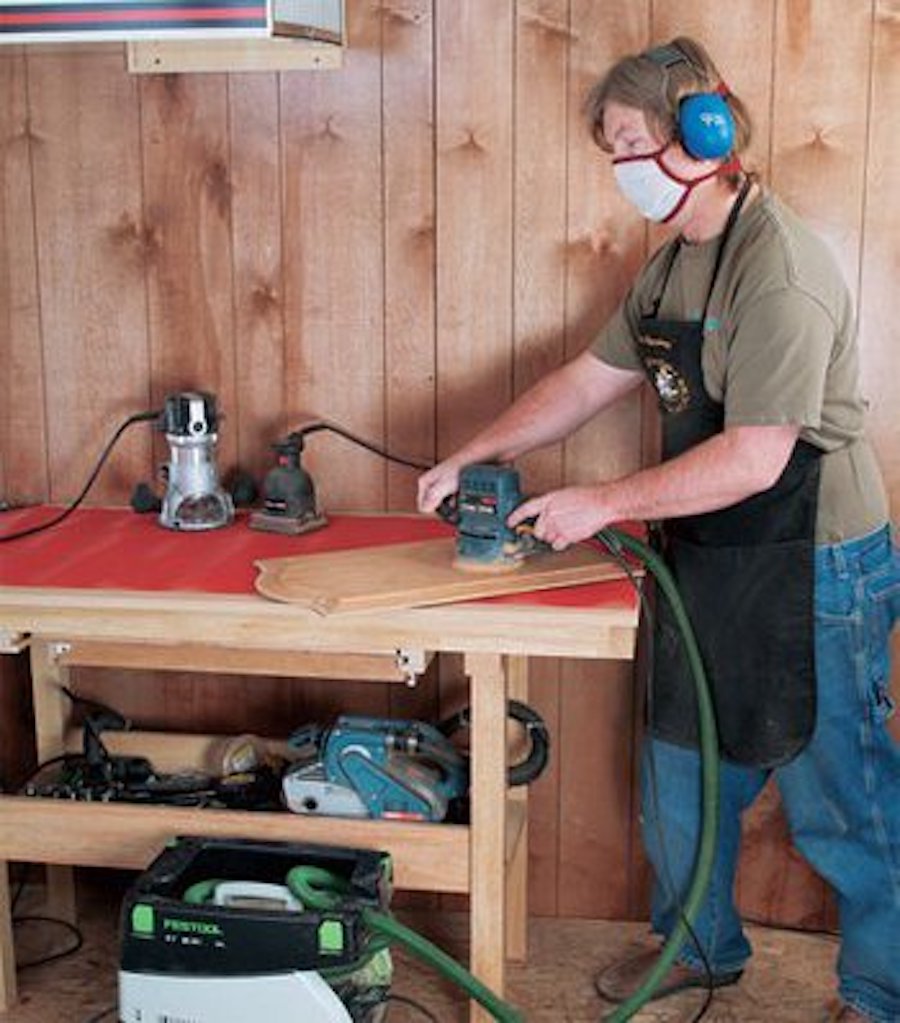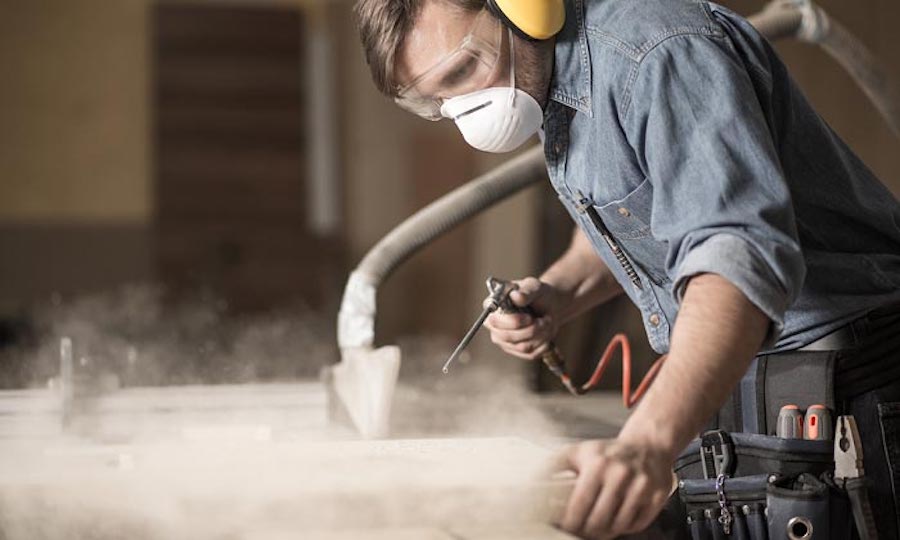Everyone is aware of the many dangers in woodworking. You think of saws and sharp tools and so you naturally think cuts and blood. You might also expect bangs and bruises from hammers and such. Now, these are all hazards in woodworking. John has lost the tippy tip of many of his fingers and even had to have surgery on a sliced tendon on the top of his hand. But thankfully he does have all his fingers!
Recently, I have been made aware of another possibly major danger in woodworking and that is the dangers of wood dust. In Ireland, has his own separate building he uses for a workshop. It has a large table saw with a vacuum dust collector but there is no dust collection apparatus on any of the other tools. So that workshop has woodchips and dust everywhere. How he has had a workshop like this for most of his retired life and probably even in the big workshop he had in Dublin. Dangers of dust inhalation is a relatively new factor in occupational health.

OSHA
OSHA- Occupational Safety & Health did not become a law until 1970 and that did not apply to home workshops. In Ireland, John was retired before laws of this type came into focus. For my purpose, I looked at the USA information.
In Ohio, we have a workshop on the lower level of the house. That level is heated with hot water and there is little ductwork in the ceiling back there. It was once my office when I had my own consulting healthcare business.
When we set the room up for a woodshop, John sealed all the door from inside so dust would not escape. We bought a wood suction extractor with a hose hook up to the table saw and John added a suction boxed area for the miter saw. He did hook up the hoses to those areas. He does use the suction with those two tools most of the time but he has no suction devices on the sander nor the router.
The trouble is that he uses those two tools very frequently and I’d say the most frequent. After he cuts his templates on the saws, he might sand a piece 3 or 4 times or more and router the edges or details in almost all the pieces, so I’d say a lot of the sawdust comes from those tools.
As is his habit in Ireland, John will sweep and Shopvac the floors periodically after he is done with a project. But I fear a lot of fine particulate dust manages to escape the area. It is that fine particulate dust that may be the cause of problems people remain unaware.
Fine Particulate
OSHA states,
“Wood dust is considered carcinogenic to humans (Group 1) according to the International Agency for Research on Cancer (IARC). IARC states that wood dust causes cancer of the nasal cavity (nose area) and paranasal sinuses (spaces in and around the nasal cavity) and of the nasopharynx (upper part of the throat, behind the nose).
Wood dust is also associated with toxic effects, irritation of the eyes, nose, and throat, dermatitis, and respiratory system effects which include decreased lung capacity and allergic reactions.” See this for more information
While shaving and wood bits can be a hazard, it is the saw dust…the finer grains, that are the most harmful. The smaller the size of the dust, the deeper into the respiratory system they can travel. Sawdust can have chemicals in it, can have dangerous natural wood elements, that by themselves are carcinogenic. However, the irritation of the dust itself can cause the body to react negatively.
Scientists also find that dust alone can act as an irritant to the eyes, the skin and both the upper breathing passages and lower lung in individuals. Asthma is a known occupational hazard well documented in carpenters and people working around wood. See California asthma publications here
Problems
Lung Injury
- Cancer- lung, nasal
- Asthma
- Lung diseases
- Skin Irritations
- Allergy
- Toxic exposure/poison
The way the respiratory system responds to inhaled particles depends, to a great extent, on where the particle settles. For example, irritant dust that settles in the nose may lead to rhinitis, an inflammation of the mucous membrane. If the particle attacks the larger air passages, inflammation of the trachea (tracheitis) or the bronchi (bronchitis) may be seen.
The most significant reactions of the lung occur in the deepest parts of this organ.
One of the most inconspicuous and scarey possibilities, besides cancer, of course, is lung injuries. In general, a lung injury from dust is described by OSA in Canada, here
Particles that evade elimination in the nose or throat tend to settle in the sacs or close to the end of the airways. But if the amount of dust is large, the macrophage system may fail. Dust particles and dust-containing macrophages collect in the lung tissues, causing injury to the lungs.
Rockler Wood Working Info Sheet
The amount of dust and the kinds of particles involved influence how serious the lung injury will be. For example, after the macrophages swallow silica particles, they die and give off toxic substances. These substances cause fibrous or scar tissue to form. This issue is the body’s normal way of repairing itself. However, in the case of crystalline silica so much fibrous tissue and scarring from that lung function can be impaired. The general name for this condition for fibrous tissue formation and scarring is fibrosis. The particles which cause fibrosis or scarring are called fibrogenic. When fibrosis is caused by crystalline silica, the condition is called silicosis.
Dust particles are measured in microns or thousandths of a millimeter. Larger dust particles – greater than 100 microns or so – are heavy enough to fall to the floor quickly. This is the debris that dust collectors are so effective at removing. Fine dust particles, on the other hand, don’t have enough mass to fall quickly to the floor and can float through the air in your shop for a surprisingly long time. Once a 5-micron wood dust particle is stirred up, it will stay aloft for 30 minutes or longer, depending on air movement. Dust particles of less than 10 microns constitute the primary respiratory health risk to woodworkers. They’re easily stirred up, stay aloft for a long time and – worse – travel easily into the deepest reaches of the lungs, where they are reported to cause problems ranging from mild allergic reactions to severe and chronic respiratory ailments. More and more woodworkers, convinced by the evidence of health risks, are beginning to take fine wood dust exposure seriously. See Rocker

Injury Prevention
- Use on-tool extraction systems.
- Keep tools and blades sharp. As tools dull, they may release more dust into the air.
- Be aware that significant exposure can happen when cleaning (e.g., emptying dust bags) or maintaining equipment.
- Practice good housekeeping. Keep surfaces and floors clear.
- Use cleaning methods that reduce re-introducing the dust into the air. Use wet clean-up methods (e.g., wipe surfaces with a wet rag or mop) or use a vacuum with a HEPA filter.
- Cover your skin if the wood is an irritation
- Make yourself aware of skin irritant wood types
- Remove or change clothing after working- do not just brush off dust unless wearing your respirator
- Do not bring dusty clothing into the home..wash
- Wear respiratory protection- good mask or respirator made for wood dust exposure
- Wet wash to clean- use a damp cloth as to trap dust not scatter it over the room
- Read OSHA and woodworking sites safety suggestion

If I scared you a bit, forgive me but I wanted to. I have been new to this wood furniture business and have never thought about any possibility of injury, except the cuts and bangs. I may not use the saw but I do use the sander…a hand sander without a bag and without any respirator…who knew. Not me.
My Conclusions
I have been recently diagnosed with a lung inflammatory condition which is still being investigated. Believe me, this is scarey stuff. While I know it’s not cancer, the docs are still trying to determine a cause. While the wood dust might not be the problem, I believe that avoidance of dust is still a good practice for me. I do use Low VOC products to finish but have never worn a mask. That is actually poor practice. If this problem is determined not to be caused by wood dust, I will still practice better safety measures.
First thing I plan on doing is obtaining a good respirator mask. Rockler does show some in its recommendation above and I will continue to research this issue.
Next, I am looking into ambient air collection filter box for the inside of the shop. John does have the suction hoses hooked up to the big equipment but small dust particles still escape into the air.

I suggest we all rethink our work areas and outfit out shops and ourselves with
reasonable safety equipment.
I enjoy painting and refinishing furniture, I will still continue but just making a few safety changes will help to ensure we can all continue in relatively safe and happy practice to avoid injury in our workshop.
I would love to hear from you if you relate to this post at all. Please leave me a comment with your suggestions.
Take good care
Talk soon
Dee






